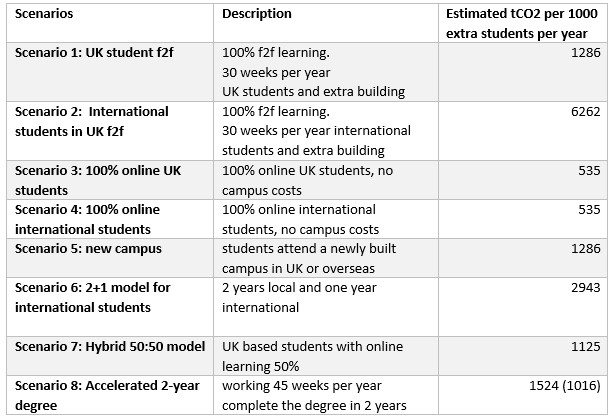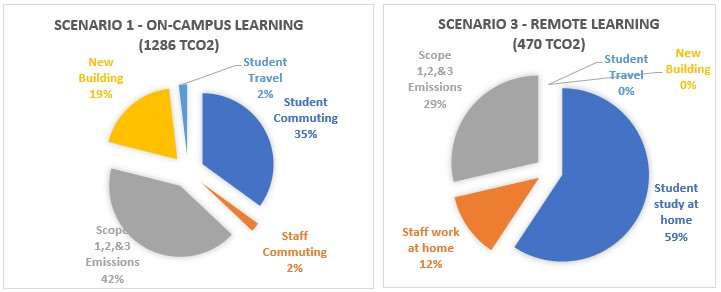In Part 1. Scaling Education we set out our assumptions to be used to compare scenarios for scaling education to meet the suggested global growth in learners in the future.
The calculator
A simple spreadsheet calculator was created using the carbon emissions figures we established in Part 1. Please email innovation@jisc.ac.uk if you would like a copy of the spreadsheet we created.
We have used this to compare several scenarios based on the carbon emissions are based on an additional 1000 students.
We modelled several scenarios to compare a variety of approaches using the emission figures.

The carbon emissions are in Metric tonnes carbon dioxide (tCO2) per year scaled for 1000 additional students.
The scenarios apply to both universities and colleges, although it would be useful to model apprenticeships and work based learning, also to vary the assumptions around the proportion of students commuting from home to college or the distance travelled.
What we discovered
Remote learning has less impact
Scaling education using remote learning has lower carbon emission than increasing student on campus learning. Assuming we are scaling on an existing education infrastructure, with no additional buildings required. Perhaps a more realistic scenario is a blended model, where students studied remotely but still attended campus for some learning and to access resources. Scenario 7 suggests a blended approach has less impact.
If we compare a breakdown of the two scenarios (see pie charts) below we see that student commuting or heating emissions are still major contributors, although smaller than the estimated Scope 1,2&3 emissions.
Existing strategies to reduce commuting emissions i.e. encourage staff and students to walk, cycle or use low carbon forms of transport could make a big difference.
Enabling students to live in energy efficient accommodation could reduce the heating emission impact. Offering students, a local study space within walking or cycling distance from their home could also have a positive impact. Looking at timetabling to reduce commuting, days on campus could also make a difference.

New buildings have a large impact
We used a figure of 246t CO2 per year, written off over 50 years to estimate the carbon impact of having to create a bigger campus for more students. However the impact would be when the building happened, so in the space of a few years.
Making use of existing buildings could be one strategy to reduce emissions. Partnering with businesses or colleges, accelerated courses (such as 2-year degrees), using local learning hubs e.g. community libraries could also be explored to reduce the impact of new buildings.
International flights make a big impact
An international flight averages at 5t CO2 per student or 5000t CO2 for the 1000 additional students in scenario 2 above. Approximately five times the impact of a UK based on-campus student. We were already aware of this fact but not the impact in comparison with the other scenarios. The model only accounts for 1 round trip per year per student. Some students may make additional flights each year, so the figure in the table is quite conservative.
Remote learning for international student is the same as for UK based students. There will be some differences, internet routers across distance maybe, access to wifi or computers in developing countries, availability of net zero carbon electricity.
The option to build locally or partner with existing institutions overseas also offers an approach to scaling education. There are currently around 60,000 students enrolled at UK University branch campuses overseas compared with 600,000 attending UK further and higher education institutions.
Scenario 6 models the emissions impact where a student studies for 2 years locally (remotely would be slightly less impact) and then travels overseas for 1 year. The emission are less than half when compared with an international student attending for three years in the UK.
Final thoughts
We should recognise the benefits of education to environmental sustainability. For example educating students about the environment. They will enter the work force with greater awareness and skills to help reduce carbon emissions. Research innovation that will allow us to address global level challenges in the longer term The role of educational institutions in reducing their own environmental impact through their business activities.
In all the scenarios there was an increased carbon impact because of scaling the number of students. As we improve our efficiency around the largest contributors i.e., building, travel, and energy we might expect to see the smaller contributions to become more significant e.g., the carbon emissions associated with technology for learning.
A variety of approaches will be taken to scale education. Institutions will need to be aware of the environmental impact and consider alternative approaches. While considering challenges such as student isolation and well-being of remote learning.
Please do share comments on our findings or suggest better estimates for the data model. Are you implementing any of the scenarios? Using a blended learning or a branch campus overseas, developing local learning hubs or partnering with other institutions. We would like to hear from you.
Please contact innovation@jisc.ac.uk
Disclaimer: This was a short 2-week sprint not a long study and the data assumptions above and the emissions calculator have not been properly checked or reviewed. Reports use grammes, kilogrammes or metric tons of carbon, sometimes by day or annual or by activity. The opportunity to one figure wrong by a factor of 1000 is just too easy. We have sense checked figures against different sources but there could still be errors and you may want to challenge our assumptions.

3 replies on “Part 2. Scaling Education: A simple carbon calculator”
I must say I’m rather concerned at the suggestion made by Paul Bailey in his blog “Part 2. Scaling Education: A simple carbon calculator”, that new buildings could afford to dispense with a dedicated academic library space in favour of shared ‘community libraries’.
“Making use of existing buildings could be one strategy to reduce emissions. Partnering with businesses or colleges, accelerated courses (such as 2-year degrees), using local learning hubs e.g. community libraries could also be explored to reduce the impact of new buildings.”
This almost throw away remark could have serious implications for college libraries whose institutions look for ways to cut costs by sacrificing their library and learning centres not to mention their library teams. It saddens me when the library and learning centre environments are singled out and made easy targets. I am frankly surprised JISC have put their name to such a suggestion when they must have a wealth of evidence to support the benefits of colleges maintaining their own libraries as essential and integral learning spaces. It’s funny how we never hear about dispensing with canteens in the same way.
Neil Atherton he/him
Neil – many thanks for your comment. Far from removing learning centres or libraries or canteens, I am suggesting we would need more. The reference to community libraries was in the context of creating local learning hubs in existing library spaces so students would not need to travel so far to find a learning space. I may be misusing the term “community library”. My intention was to encourage users to make more use of existing buildings by preference, or where possible, to be more sustainable.
Hi Paul, Thanks for your response. I’m sorry but it looked like you were suggesting colleges explore avenues to reduce their carbon footprint on new builds by outsourcing their library services.